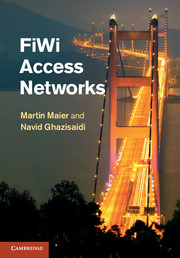Book contents
- Frontmatter
- Contents
- List of figures
- List of tables
- Preface
- Acknowledgments
- Part I Introduction
- Part II Fiber access networks
- Part III Wireless access networks
- Part IV FiWi access networks
- 10 RoF vs. R&F networks
- 11 Architectures
- 12 Network planning and reconfiguration
- 13 Techno-economic analysis
- 14 Network coding
- 15 Optical and wireless protection
- 16 Hierarchical frame aggregation
- 17 Routing and QoS continuity
- 18 Smart grid communications
- References
- Index
13 - Techno-economic analysis
from Part IV - FiWi access networks
Published online by Cambridge University Press: 05 January 2012
- Frontmatter
- Contents
- List of figures
- List of tables
- Preface
- Acknowledgments
- Part I Introduction
- Part II Fiber access networks
- Part III Wireless access networks
- Part IV FiWi access networks
- 10 RoF vs. R&F networks
- 11 Architectures
- 12 Network planning and reconfiguration
- 13 Techno-economic analysis
- 14 Network coding
- 15 Optical and wireless protection
- 16 Hierarchical frame aggregation
- 17 Routing and QoS continuity
- 18 Smart grid communications
- References
- Index
Summary
Recently, various fiber-wireless (FiWi) network architectures have been investigated by integrating different optical and wireless technologies. While introducing optical fiber at higher network layers, e.g., aggregation layer, helps alleviate emerging bandwidth bottlenecks, the last hop is expected to be wireless for ubiquity and convenience, e.g., low-cost wireless home area networks (HANs) (He et al. [2008]). Between these two FiWi network hierarchy levels lies the “sweet spot” where optical technologies interface with their wireless counterparts. Two important sweet-spot technologies that play a key role in emerging FiWi networks are Ethernet passive optical network (EPON) and WiMAX. Clearly, EPON and WiMAX networks may be cascaded, as proposed in (Shen et al. [2007]). However, given the similarities of EPON and WiMAX (e.g., point-to-multipoint topology with a central control station performing dynamic bandwidth allocation (DBA) by means of centralized polling and scheduling) we argue that the two technologies are more likely to target the same network segment rather than being cascaded to cover different network segments. In other words, we expect that network operators will make a choice between EPON and WiMAX depending on a number of factors, e.g., right-of-way, and elaborate on the techno-economic comparison of the two technologies.
For the comparison of wired and wireless network technologies various techno-economic evaluation techniques have been proposed, as we will see shortly. During the last decade, the techno-economic evaluation of various network technologies has been an active research area.
- Type
- Chapter
- Information
- FiWi Access Networks , pp. 146 - 159Publisher: Cambridge University PressPrint publication year: 2011



